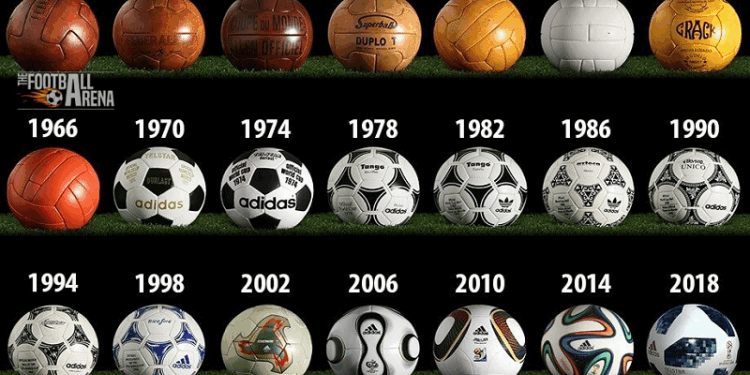Each World Cup edition has its own stories, anecdotes, heroes, but also balloons. Since 1970, Adidas has been the official manufacturer of the World Cup balloons.
But these balloons already existed before 1970. Since exactly 1930, the date of the very first World Cup in Uruguay. Here are their stories …
Uruguay 1930: T-Shape
The T-Shape was the ball used during the first World Cup in 1930 in Uruguay. It was characterized by its 12 T -shaped faces.
Italy 1934
This model was used during the second World Cup in 1934 which took place in Italy.
France 1938: Allen
Allen is the name of the ball used in France during the World Cup in 1938. Unlike its predecessors, this model was made up of 13 leather faces.
Brazil 1950
The official ball of the 1950 World Cup in Brazil was made up of 12 leather faces. This model was inflated like the current balls, thanks to a valve.
Switzerland 1954
The official ball of the 1954 World Cup in Switzerland. For the first time, we used a colored (yellow) balloon and consisted of 18 leather faces. Surface, it was printed with the following characters: Swiss World Champion Match Ball.
Sweden 1958
This ball was used during the 1958 World Cup in Sweden. Its design is very similar to the 1954 model.
Chile 1962: Santiago
First model of balloon to have long octagonal faces. Called Santiago by Adidas, it was used during the 1962 World Cup in Chile.
England 1966: Challenge
This ball was used during the 1966 World Cup in England. This model very similar to that of 1958 with the difference its orange color. During the following World Cups, all the balloons were designed by Adidas.
Mexico 1970: Telstar
Created by Adidas, Teltar was the official ball of the 1970 and 1974 World Cups organized respectively by Mexico and Germany (FRG). This model was designed with black and white faces so that it is more visible on television screens.
RFA 1974: Teltar Durlast
The color of the marking will be the only difference with the model used for the 1970 World Cup in Mexico.
Argentina 1978: Tango Rosario
The tango created by Adidas was the official ball of the 1978 World Cup in Argentina. A real revolution in manufacturing since its design model will be used for the next twenty years: 20 identical faces in real waterproof leather formed a design with 7 circles. At the time, tango was the most expensive ball in history.
Spain 1982: Tango España
Adidas created this new ball for the 1982 World Cup in Spain. The Tango España was supposed to be more resistant thanks to rubber seams. Finally, it was changed several times during matches and this manufacturing technique will not be reused thereafter. This ball will be the last in real leather to be used in the World Cup.
Mexico 1986: Azteca
Inspired by Aztec architecture, this ball was the first fully synthetic ball. It will be used during the 1986 World Cup in Mexico.
Italy 1990: Etrusco Unico
The Etrusco Unico was created by Adidas in the early 90s. It will be the official ball of the 1990 World Cup in Italy and Euro 1992 in Sweden. Three lion heads decorate each of the 20 sides.
United States 1994: Questra
Adidas Questra, the official ball of the 1994 World Cup in the United States of America. This model was appreciated by the players for its speed and control but criticized by the goalkeepers who complained about its unpredictability.
France 1998: Tricolore
First balloon with more than two colors used for a final phase, Tricolor of Adidas was the official ball of the 1998 World Cup in France. The use of blue was to recall the color of the French national team whose country organized competition. Tricolor will be the first ball made elsewhere than in Europe (Morocco) since the 1970 Telstar.
Japan and South Korea 2002: Fevernova
Fevernova was the first ball to separate from the traditional design of tango since 1978. Created by Adidas for the 2002 World Cup, organized jointly by Japan and South Korea, its look surprises by its colors and its side and revolutionary inspired by Asian culture.
Germany 2006: Teamgeist
The teamgeist was drawn by Adidas Innovation Team and the Molten Corporation and created by Adidas for the 2006 World Cup in Germany. This balloon only included 14 sides. Each game in the final phase had its own balloons, with the date of the match, the stadium and the teams printed on the surface. For the final, balloons called “teamgeistberlin” were golden in color.
South Africa 2010: Jabulani
Jabulani (in Zulu, being happy) is the official ball of the 2010 Football World Cup made by Adidas. It was presented on December 4, 2009 at CAP. It was designed and developed specially for this event which took place from June 11 to July 11, 2010 in South Africa. He sports eleven unique colors, in tribute to the 11 players of each team, the eleven languages spoken in South Africa, and the eleven South African communities which will be hosts of this tournament.
Brazil 2014: Brazuca
Brazuca is an informal term used by Brazilians to describe national pride through the Brazilian lifestyle. His nickname was chosen in 2012 by Internet users during a vote in which many Brazilians participated. They had the choice between “Brazuca”, “Bossa Nova” and “Carvanalesca”.
Russia 2018: Teltar Mechta
Teltar is the contraction of “television star”. This model was designed in 1970 with black and white faces so that it is more visible on television screens.
Teltar Mechta (in photo) replaces the Telstar 18 from the knockout stages of the 2018 World Cup in Russia.
Qatar 2022: Al Rihla
Al Rihla means “travel” in Arabic. Inspired by the flag and the architecture of Qatar, the official ball of the Football World Cup displays a design with colorful lines








